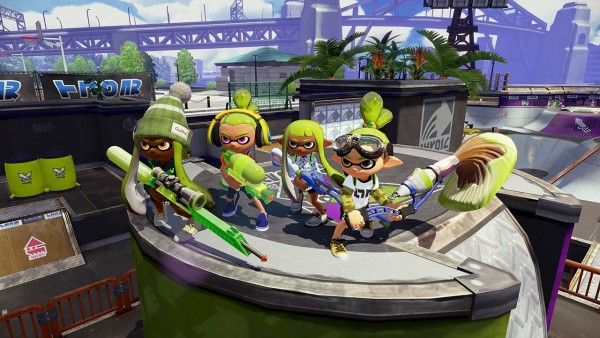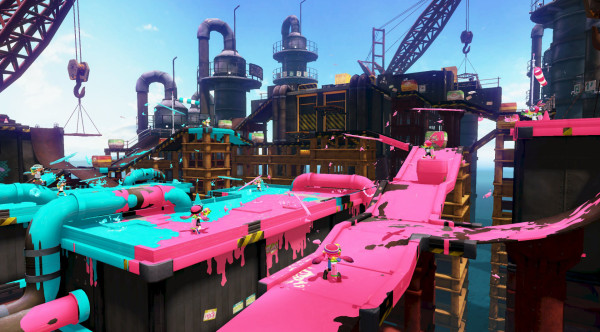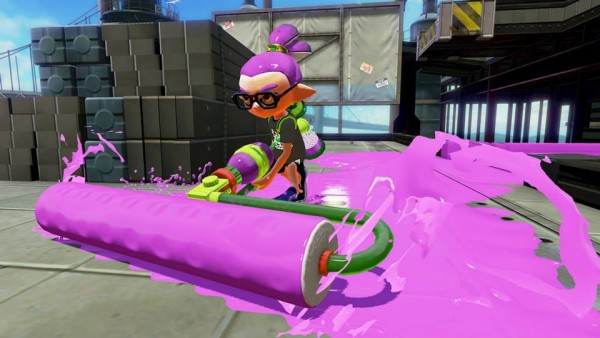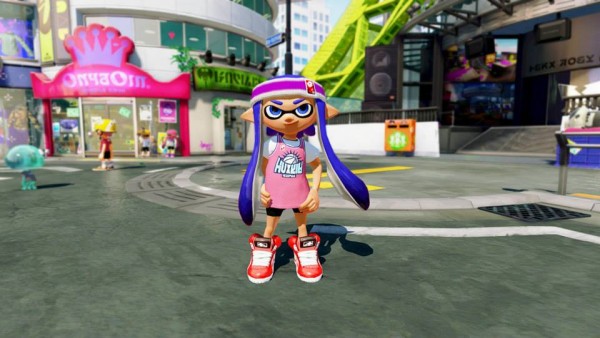For a company frequently accused of being somewhat out of touch when it comes to the Internet (let’s not get into that pesky YouTube IP issue), it’s fascinating to watch how Nintendo have started to embrace eSports in the last year. From Super Smash Bros. Melee making an official appearance at EVO, to their pre-release, public ‘Invitationals’ to test Super Smash Bros. for Wii U and 3DS, it’s clear that Nintendo is trying to build some bridges with its multiplayer communities. These are baby-steps, still, but it’s a definite start.
It’s not often that Nintendo launch a new IP, never mind one that targets a more online-centric fan-base, but that’s exactly what the team-based, third-person shooter Splatoon on the Wii U seems to be. While I don’t doubt Nintendo will stuff the game chock-full of smart single-player modes and challenges, Splatoon appears to be an attempt to attract the type of gamer who might be more comfortable with the likes of Team Fortress 2, DOTA 2 or even Destiny than, say, Super Mario Sunshine. So when I recently had the opportunity to take part in two of the hour-long Splatoon Global Testfire sessions – offering multiplayer matches with real players, pre-release – I jumped at the chance.

In an interesting twist, players can transform from their normal ‘Inkling’ form into a Blooper-like ‘Squid’
Before diving into live matches, the demo boots players straight into a small tutorial, outlining the central game mechanic of laying paint on surfaces with the gamepad. Motion-control is used to aim your Splattershot gun, but players can optionally switch to a more traditional dual-analog setup, a welcome addition for gamers not used to Nintendo’s large controller. In an interesting twist, players can transform from their normal ‘Inkling’ form into a Blooper-like ‘Squid’; by doing so, they sacrifice some defense, but gain massive mobility by being able to swim through any painted surfaces of their team’s colour. Combined with the painting mechanic, this creates any number of unique strategies, especially when you start to factor in the verticality of some map surfaces.
Speaking of the maps, only two were available during the Global Testfire: Walleye Warehouse, a basic layout concealing some sneaky side-paths; and Saltspray Rig, a more esoteric map, featuring disjointed vertical pathways and tight corridor-like combat areas. Multiplayer appeared to load these maps on a random rotation, and regardless of selection, the Testfire was limited to one gameplay mode: Turf Wars.

Here, players are tasked with using their weapon of choice (more on that in a bit!) to lay down as much paint on the surface area of the map as possible, all over the course of three exhilarating minutes. And that last part is crucial; every second counts here, as I found that players were able to swing the match in its last moments by making a paint run for a long-forgotten area of the map. To aid this, the gamepad displays a handy overview of the map, giving an run-down of the paint distribution between teams. It can also be used to re-spawn close to any active players (simply tap next to them!), should you fall pray to an enemy Splattergun.
While the Splatoon demo didn’t feature classes, per se, it did contain four weapons that are different enough to change up the gameplay significantly on their own merits. The default Splattershot has solid range and does decent damage, but doesn’t have any outstanding attributes otherwise. The Splattershot Jr., meanwhile, operates as a sub-machine gun variant of its older brother, trading some damage for a higher rate of fire, suggesting chaotic possibilities for splatting enemy terrain.

One of the more unique weapons is the Splat Charger, a sort of hybrid between a sniper-rifle and Quake III: Arena’s legendary Railgun, firing long lines of paint instead of blobs. It’s a little hard to get a handle on, initially, but its significant damage output may reward players in the long-run. Finally, the demo weapon selection was rounded-off with the controversial Splat Roller, a weapon which allows players to paint the surfaces of a level as they move. It operates somewhat like the flamethrower of Team Fortress 2 fame, offering a devastating frontal attack and paint range at the expense of leaving players weak at the rear. Many have already taken to Twitter to blast the Roller as being overpowered, but it wouldn’t surprise me if inventive anti-Roller strategies develop over the weeks following the game’s launch.
Indeed, probably the first thing you’ll notice while playing is its striking visual design
There are plenty of assault options left to discuss – like the secondary grenade weapons, or the more assist-focused weaponry, such as the Bubbler – but it’s almost unfair to Splatoon that I’ve spent so long talking about the game without mentioning its fantastic presentation. Indeed, probably the first thing you’ll notice while playing is its striking visual design; from the bright neon paints which intentionally clash with one another, to the punk-chic character design of its teenage combatants, Splatoon revels in colour and whimsy on a level that would have proponents of the Blue Skies in Games campaign weeping in joy. The icing on the cake is the rock-solid 60FPS refresh rate, which keeps the action smooth and responsive to match the game’s hectic pace. Of course, this wouldn’t be a Nintendo title without a memorable soundtrack, and this game has that in spades. Try to imagine dropping Jet Set Radio, Katamari Damacy and WarioWare into a blender, and you’ll start to approach the madness of Splatoon’s background beats.

While I have no problem heaping praise upon Splatoon’s fun core gameplay and wonderful style, I do have some concerns moving forward. For a start, we’ve heard basically nothing about the supposedly meaty single-player mode (though some details are starting to leak in early reviews), which could be worrisome if the online backing for multiplayer isn’t up to snuff. But even if the focus remains decidedly on the multiplayer, the game currently lacks any voice-chat, normally a vital component for team co-operation in both casual and professional competitive play.
If Nintendo can support the game as well as their enthusiastic press suggests, they may well have a new franchise on their hands.
Additionally, players are already afraid that there may not be enough maps to sustain the game long-term. It’s hard not to look back on other titles released this year, such as Turtle Rock’s Evolve, and recall how their multiplayer numbers plummeted in the weeks following release. That said, Nintendo have already promised additional free maps down the road, so if they can support the game as well as their enthusiastic press suggests, they may well have a new franchise on their hands.
My brief time with the Testfire certainly left me wanting more… come splat me, bro!
Leave a Reply
You must be logged in to post a comment.